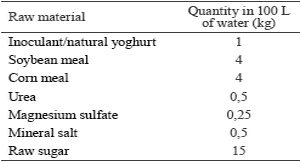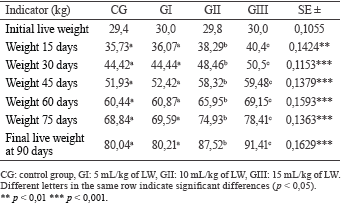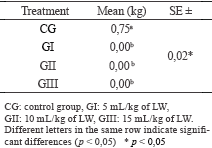Effect of VITAFERT® on the productive and health performance of growing-fattening pigs
The objective of the study was to evaluate the effect of the zootechnical additive VITAFERT® on the productive and health performance in pigs, in the growing-fattening stage. Four inclusion levels of VITAFERT® were used, which constituted the treatments: CG: control group, GI: 5 mL/kg of live weight (LW), GII: 10 mL/kg of LW and GIII: 15 mL/kg of LW, with five repetitions each and a completely randomized design. In the case of the productive variables variance analysis was used; and Duncan’s test was applied to compare the differences among means, through the package INFOSTAT®. To establish whether there were statistical differences in the incidence of diarrheas and mortality, analysis of proportions was carried out and ComparPro version 1 was used. As the VITAFERT® levels were increased there was a rise (p < 0,001) in the mean daily gain of live weight (0,64; 0,64; 0,71 and 0,75 kg), which brought about an increase (p < 0,001) in the total live weight gain at the end of rearing (57,36; 57,36; 64,30 and 67,68 kg). The feed conversion (kg of DM per kg of LW increase) was favored by the increase (p < 0,001) of the product doses, with values of 4,38; 4,37; 3,90 and 3,73. Likewise, when including the zootechnical additive there was a decrease in the incidence of diarrhea. The inclusion of VITTAFERT® in the feeding of pigs in the growing-fattening stage improved the productive and health performance, and the best results were obtained with the highest dose.
Keywords: animal performance, diarrhea, probiotics.
| Table 1. Chemical composition of the concentrate feed. | Table 2. Formulation of the zootechnical additive VITAFERT® | |
 |  |




Ayala, Lázara; Bocourt, R.; Castro, M.; Dihigo, L. E.; Milián, Grethel; Herrera, Magalys et al. Development of the digestive organs in piglets born from sows consuming probiotic before farrowing and during lactation. Cuban J. Agric. Sci. 48 (2):133-136, 2014.
Beruvides, A.; Elías, A.; Valiño, Elaine C.; Milián, Grethel; Rodríguez, Marlen & González, R. Comportamiento productivo y de salud en lechones lactantes suplementadas con azúcar fermentado con yogurt. LRRD. 30 (4). http://www. lrrd.org/lrrd30/4/agust30072.html. [05/03/2018], 2018.
Di Rienzo, J. A.; Casanoves, F.; Balzarini, Mónica G.; González, L.; Tablada, M. & Robledo, C. W. InfoStat versión 2012. Córdoba, Argentina: Grupo InfoStat, FCA, Universidad Nacional de Córdoba. http://www.infostat.com.ar. [09/06/2017], 2012.
Duncan, D. B. Multiple range and multiple F test. Biometrics. 11 (1):1-42, 1955.
Elías, A. & Chiliborste, P. Experiencias en la producción de alimentos por vías biotecnológicas en sistemas pecuarios de la República del este de Uruguay. Memorias del III Congreso de Producción Animal Tropical. La Habana, Cuba: Instituto de Ciencia Animal. p. 234-236, 2010.
FAO. Cerdos. Roma: FAO. http://www.fao.org/ag/ againfo/themes/es/pigs/home.html. [02/01/2018], 2014b.
FAO. Cerdos y producción animal. Roma: FAO. http:// www.fao.org/ag/againfo/themes/es/ pigs/production.html. [02/01/2018], 2014ª.
Flores-Mancheno, L. G.; García-Hernández, Yaneisy; Proaño-Ortiz, F. B. & Caicedo-Quinche, W. O. Evaluación de tres dosis de un preparado microbiano, obtenido en Ecuador, en la respuesta productiva y sanitaria de cerdos en posdestete. Rev. Cien. Agri. 12 (2):59-70, 2015.
Font, H.; Noda, Aida; Torres, Verena; Herrera, Magaly; Lizazo, D.; Sarduy, Lucía et al. Paquete estadístico ComparPro versión 1. San José de las Lajas, Cuba: Instituto de Ciencia Animal, 2007.
García-Hernández, Y.; Pérez-Sánchez, T.; Boucourt, R.; Balcázar, J. L.; Nicoli, J. R.; Moreira-Silva, J. et al. Isolation, characterization and evaluation of probiotic lactic acid bacteria for potential use in animal production. Res. Vet. Sci. 108:125-132, 2016.
Giang, H. H.; Viet, T. Q.; Ogle, B. & Lindberg, J. E. Effects of supplementation of probiotics on the performance, nutrient digestibility and faecal microflora in growing-finishing pigs. AsianAust. J. Anim. Sci. 24 (5):655-661, 2011.
Heo, J. M.; Opapeju, F. O.; Pluske, J. R.; Kim, J. C.; Hampson, D. J. & Nyachotí, C. Gastrointestinal health and function in weaned pigs: a review of feeding strategies to control post-weaning diarrhoea without using in-feed antimicrobial compounds. J. Anim. Physiol. Anim. Nutr. (Berl). 97 (2):207-237, 2013.
Hou, C.; Zeng, X.; Yang, F.; Liu, H. & Qiao, S. Study and use of the probiotic Lactobacillus reuteri in pigs: a review. J. Anim. Sci. Biotechnol. 6 (1):14. https://jasbsci.biomedcentral. com/articles/10.1186/s40104-015-0014-3.[18/01/2018], 2015.
Ihara, Y.; Hyodo, H.; Sukegawa, S.; Murakami, H. & Morimatsu, F. Isolation, characterization, and effect of administration in vivo, a novel probiotic strain from pig feces. Anim. Sci. J. 84 (5):434- 441, 2013.
IIP. Manual de procedimientos técnicos para la crianza porcina. La Habana: EDIPORC, Ministerio de la Agricultura, 2015.
Jurado-Gómez, H.; Ramírez, Cristina & Martínez, J. Evaluación in vivo de Lactobacillus plantarum como alternativa al uso de antibióticos en lechones. Revista MVZ Córdoba. 18 (supl. 1):3648- 3657, 2013.
Linares, L. Los desafíos nutricionales frente a las restricciones de uso de aditivos: eliminación de uso de antibiótico. XXIV Congreso Latinoamericano de Avicultura 2015. Guayaquil: Asociación Latinoamericana de Avicultura. https://www.engormix.com/avicultura/articulos/ los-desafios-nutricionales-frente-t32625.htm. [18/01/2018], 2015.
López, S. Acidificantes en primeras edades de lechones y aves. Nuestra cabaña. 298, 2000.
Milián-Florido, Grethel; Rondón, Ana J.; Pérez, M.; Arteaga, Fátima G.; Bocourt, R.; Portilla, Yadileiny et al. Methodology for the isolation, identification and selection of Bacillus spp. strains for the preparation of animal additives. Cuban J. Agric. Sci. 51 (2):197-207, 2017.
Pérez-Quintana, M.; Milián-Florido, Grethel; Rondón, Ana J.; Bocourt-Salabarría, R. & Torres, Verena. Efecto de endosporas de Bacillus subtilis E-44 con actividad probiótica sobre indicadores fermentativos en órganos digestivos e inmunológicos de pollos de engorde. Rev. Soc. Ven. Microbiol. 35 (2):89-94, 2015.
Quemac-Males, Mayra L. Evaluación de tres dosis de probiótico (Rhodopseudomonas spp, Lactobacillus spp, Saccharomyces spp) en la alimentación para el engorde de cerdos. Tesis de grado previa la obtención del título de Ingeniera en Desarrollo Integral Agropecuario. Tulcán, Ecuador: Facultad de Industrias Agropecuarias y Ciencias Ambientales, Escuela de Desarrollo Integral Agropecuario, Universidad Politécnica Estatal del Carchi, 2014.
Rodríguez, M. Evaluación de la capacidad antibacteriana de PROBIOLEV® frente a bacterias patógenas. Ph. D. Thesis. San José de las Lajas, Cuba: Instituto de Ciencia Animal, 2017.
Rondón, Ana J.; Ojito, Yurién; Arteaga, Fátima G.; Laurencio, Marta; Milián, Grethel & Pérez, Y. Probiotic effect of Lactobacillus salivarius C-65 on productive and health indicators of lactating piglets. Cuban J. Agric. Sci. 47 (4):401-407, 2013.
Sánchez-Gaitán, F. A. Efecto de un aditivo nutracéutico en cerdos de levante sobre parâmetros productivos. Participación activa en proyectos de investigación disciplinar o interdisciplinar para optar al título de Zootecnista. Bogotá: Facultad de Ciencias Agropecuarias, Universidad de La Salle, 2016.
Vitaluña-Moya, O. V. Evaluación de diferentes niveles de VITAFERT en crecimiento-engorde de cerdos. Tesis de grado previo a la obtención del título Zootecnista. Riobamba, Ecuador: Escuela Superior Politécnica de Chimborazo, 2014.








